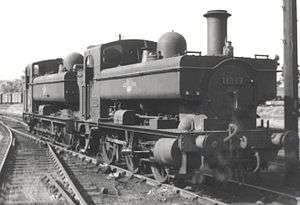GWR 1366 Class
|
GWR 1366 Class 0-6-0PT No. 1367 at Weymouth in 1961. Note the outside cylinders - the 0-6-0PT behind has the more common inside cylinder arrangement | |||||||||||||||||||||||||||||||||||||||||||||||
| |||||||||||||||||||||||||||||||||||||||||||||||
| |||||||||||||||||||||||||||||||||||||||||||||||
| |||||||||||||||||||||||||||||||||||||||||||||||
| |||||||||||||||||||||||||||||||||||||||||||||||
The Great Western Railway (GWR) 1366 Class was a class of 0-6-0 pannier tank steam locomotive built in 1934.
History and development
The 1366 class was one of only two pannier tank designs built by the GWR that utilised outside cylinders, although various existing engines inherited by the GWR had Pannier Tanks and outside cylinders. The 1366 class was developed from the 1361 Class but differed by including a pannier tank rather than a saddle tank, Belpaire firebox, etc. They were designed to replace the 1392 Class.
Operational history
The six engines of the class all remained in operation to be taken over by British Railways Western Region in 1948. They were a useful design and because of their light weight and short wheelbase, were often used on dockside branches with sharp curvatures, including that at Weymouth, Dorset.
In 1950 three locomotives were stationed at Swindon and three at Weymouth.[1] By 1958, two still remained at Weymouth, despite the shed now being within British Railway's Southern Region and one was now allocated to Taunton, with three locomotives still at Swindon. One example, No. 1369, survives on the South Devon Railway.[2]
See also
- GWR 0-6-0PT – list of classes of GWR 0-6-0 pannier tank, including table of preserved locomotives
References
- Notes
- ↑ Allan 1950, p. 21
- ↑ Fox & Hall 1993, p. 7
- Bibliography
- Allan, Ian (1950). ABC of British Railway Locomotives - Western Region. Hersham: Ian Allan. reprinted in facsimile edition, ISBN 978-0-7110-3106-7
- Fox, Peter; Hall, Peter (1993). Preserved Locomotives of British Railways. Platform 5 Publishing. ISBN 1-872524-54-0.
- le Fleming, H.M. (April 1958). Part 5: Six-coupled Tank Engines. The Locomotives of the Great Western Railway. Oxford: RCTS. ISBN 0-901115-35-5. OCLC 500544510.
- Whitehurst, Brian (1973). Great Western engines, names, numbers, types, classes: 1940 to preservation. Oxford: Oxford Publishing Company. pp. 17, 102, 165. ISBN 0-902888-21-8. OCLC 815661.
External links
| Wikimedia Commons has media related to GWR 1366 Class. |
- http://www.greatwestern.org.uk/m_in_060_1366.htm
- http://www.southdevonrailwayassociation.org/1369-hist.html
